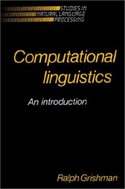Information Extraction: Knowledge Discovery from Text: Difference between revisions
From HLT@INESC-ID
No edit summary |
mNo edit summary |
||
| (One intermediate revision by the same user not shown) | |||
| Line 5: | Line 5: | ||
|email=grishman@cs.nyu.edu | |email=grishman@cs.nyu.edu | ||
|www=http://cs.nyu.edu/cs/faculty/grishman/ | |www=http://cs.nyu.edu/cs/faculty/grishman/ | ||
|bio= Ralph Grishman is Professor of Computer Science at New York | |bio= Ralph Grishman is Professor of Computer Science at New York University. He has been involved in research in natural language processing since 1969, and since 1985 has directed the Proteus Project, with funding from DARPA, NSF, and other Government agencies. The Proteus Project has conducted research in natural language text analysis, including information extraction, and has been involved in the creation of a number of major lexical and syntactic resources, including Comlex, Nomlex, and NomBank. He is a past president of the Association for Computational Linguistics and the author of the text Computational Linguistics: An Introduction.}} | ||
University. He has been involved in research in natural language | |||
processing since 1969, and since 1985 has directed the Proteus | |||
Project, with funding from DARPA, NSF, and other Government | |||
agencies. The Proteus Project has conducted research in natural | |||
language text analysis, including information extraction, and | |||
has been involved in the creation of a number of major lexical | |||
and syntactic resources, including Comlex, Nomlex, and NomBank. | |||
He is a past president of the Association for Computational | |||
Linguistics and the author of the text Computational Linguistics: | |||
An Introduction.}} | |||
== Date == | == Date == | ||
| Line 28: | Line 18: | ||
== Abstract == | == Abstract == | ||
Much of the information on the Web is encoded as text, in a | Much of the information on the Web is encoded as text, in a form which is easy for people to use but hard for computers to manipulate. The role of information extraction is to make the structure of this information explicit, by creating data base entries capturing specified types of entities, relations, and events in the text. We consider some of the challenges of information extraction and how they have been addressed. In particular, we consider what knowledge is required and how the means for creating this knowledge has developed over the past decade, shifting from hand-coded rules to supervised learning methods and now to semi-supervised and unsupervised techniques. | ||
form which is easy for people to use but hard for computers to | |||
manipulate. The role of information extraction is to make the | |||
structure of this information explicit, by creating data base | |||
entries capturing specified types of entities, relations, and events | |||
in the text. We consider some of the challenges of information | |||
extraction and how they have been addressed. In particular, | |||
we consider what knowledge is required and how the means for | |||
creating this knowledge has developed over the past decade, | |||
shifting from hand-coded rules to supervised learning methods | |||
and now to semi-supervised and unsupervised techniques. | |||
[[category:Seminars]] | [[category:Seminars]] | ||
[[category:Seminars 2009]] | [[category:Seminars 2009]] | ||
[[category:Invited Presentations]] | [[category:Invited Presentations]] | ||
Latest revision as of 14:21, 20 May 2009
| Ralph Grishman |
 |
| Addresses: www mail |
Date
- 14:15, Monday, May 25th, 2009
- Room 336
Speaker
- Ralph Grishman, New York University, USA
Abstract
Much of the information on the Web is encoded as text, in a form which is easy for people to use but hard for computers to manipulate. The role of information extraction is to make the structure of this information explicit, by creating data base entries capturing specified types of entities, relations, and events in the text. We consider some of the challenges of information extraction and how they have been addressed. In particular, we consider what knowledge is required and how the means for creating this knowledge has developed over the past decade, shifting from hand-coded rules to supervised learning methods and now to semi-supervised and unsupervised techniques.